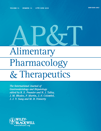Clinical trial: five or ten cycles of granulocyte–monocyte apheresis show equivalent efficacy and safety in ulcerative colitis
Abstract
Aliment Pharmacol Ther 31, 1286–1295
Summary
Background Ulcerative colitis is characterized by leucocyte infiltration into the colonic mucosa. Granulocyte–monocyte apheresis depletes these cells.
Aim To assess the non-inferiority of 5–10 apheresis treatments in patients with steroid-dependent or steroid-refractory ulcerative colitis.
Methods A total of 196 adults with moderate–severe ulcerative colitis were randomized 1:1 to 5 (n = 96) or 10 (n = 90) open label apheresis treatments. The primary endpoint was non-inferiority of clinical activity index score after 12 weeks.
Results The intent-to-treat population comprised 82 and 80 patients for the 5- and 10-treatment groups, respectively. The difference between the two groups in mean clinical activity index was 0.24 with an upper 95% confidence interval of 1.17, which was below a predefined non-inferiority threshold of 1.33. Clinical activity index score improved from baseline in both groups (from 8.7 to 5.6 with 5 treatments, and from 8.8 to 5.4 with 10), with no significant difference between the groups (P = 0.200). Outcomes for the 5- and 10-treatment groups were similar – Clinical remission: 44% and 40%, respectively (P = 0.636); clinical response: 56% and 59%, respectively (P = 0.753). The treatment was well tolerated in both groups.
Conclusions This prospective study comparing apheresis regimens in ulcerative colitis demonstrates that 5 treatments were not inferior to 10 treatments in steroid-refractory or -dependent ulcerative colitis.




